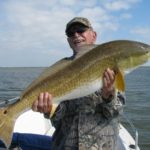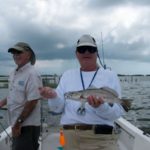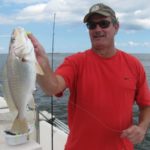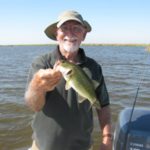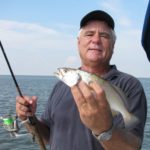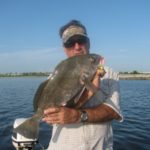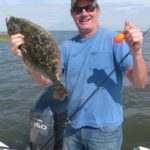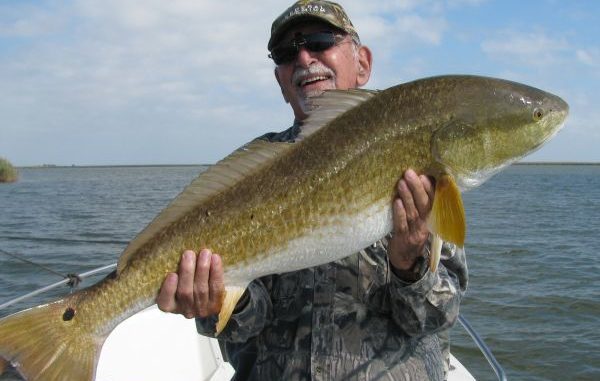
Sure, you can head outside to find limits of trout, but if the wind’s howling or you are pressed for time, just head to the area surrounding the Wall to find action that will keep you laughing.
The RSVPs to Doc and Trisha’s “third anniversary engagement party” were pouring in. It looked like everybody was coming — and then some.
You read right: “anniversary engagement party.”
Not “anniversary party” or “engagement party.” This latter party, as you might guess, was celebrated upon the actual announcement of the engagement — three years ago.
Customarily, next would come the “rehearsal parties” and/or “bachelor” and “bachelorette parties.” But not here.
You see, no official date upon which the conditions of bachelor and bachelorette actually end have been announced. So, to make up for this dearth in party excuses — and in the case of the women, to perhaps jump-start things — we hold these anniversary engagement parties that always feature huge platters of fresh fried and grilled fish.
Alas — as revealed by a quick inventory — we would need much more fish than our pooled reserves could provide. This seems to be happening a lot lately to us in early summer.
Hauling it way out to the middle of Breton Sound for decent salinities and concentrations of specks this time of year is getting old, especially when it involves (as is so often the case) beating yourself half to death mile after spray-drenched mile against stiff east winds.
So we’d made only a couple of those trips, and quickly consumed much of the catch.
Now, given time and logistical constraints, a “close” trip was called-for. In our case, this usually means the Chalmette area.
It’s a short, easy ride, mostly on Interstate. Nothing to it.
Commando fishing, we call it. In quick; out quick.
“Don’t tell me we’re gonna be fishing da wall!” Artie moaned. “Everybody knows that’s fall and winter fishing, for crying out loud! Ya can’t possibly be that dumb, after all these years!”
“Cool your jets, Artie.” Pelayo snickered. “We’ll certainly make a few casts at the wall. Heck, it’s on the way, so why not? But from there we’ll head east, try a little more deepwater jigging at the Castle, and then broaden our horizons with some traditional cork fishing in the Proctor Point marsh area. Weatherman’s calling for southeast winds, so that portion of Lake Borgne’s shoreline, with all the cuts, should be calm and fairly clear. We’ll work it over good.
“Then the ace up my sleeve: We’ll work the rock shoreline of the MRGO east of the Violet Canal — waaaw-da’s been pretty in that sheltered area. Nothing like the wind-whipped, muddy stuff coming in from Lake Borgne through Martello Castle, Bayou Thomas, Bienvenue, etc.
“Ya follow what I’m saying, Artie? Shoot, man: Didn’t you hear of my trip to that area last week? Even got into a few green-trout, mixed with drum and reds. Sure, the waawda in that area has gotten fresher since the MRGO closing. But it also remains clearer than those open to Lake Borgne, especially during windy periods. This means the specks and white trout ain’t as numerous in the area nowadays.
“But the reds, drum and sheepshead — as even you must know at this stage of the game — aren’t as finicky about needing salty waaaw-da. So you can still catch half a box-a-mixed in that area, easy — as we did last week. Ya follow me?”
Artie did just that, four days later for the “engagement party fishing trip.” He grabbed his Mitchell 300 on his solid-fiberglass pole, his Daiwa “skirted spool” spinning reel/rod combo and followed Pelayo into his truck. Artie’s vintage package probably set his dad back about $17 dollars at Security on Carrolton.
“Nope,” Artie corrected Pelayo. “They came from Frichter’s on Paris Road in Da Parish. And the Daiwa from Swagaman’s on Vets — my birthday present. Then we went to see Archie Manning’s opening game with the Saints at Tulane Stadium.”
That Archie has a memory like a steel trap — at least for fun memories. Just don’t ask him where he left his keys.
Twenty minutes after hitching Pelayo’s boat we were on Paris Road crossing Da Green Bridge. Twenty minutes after that we were making our first few casts along the Wall right before turning down the MRGO towards Martello Castle, casting tandem 3/8-ounce jigheads with chartreuse curly tails or Gulps.
This combo always seems to work best for us in this area, summer or winter.
“Whoa!” Pelayo groaned as he set the hook on something solid. “Looks like a few stuck around after the winter!”
“It ain’t acting like a red,” Artie cautioned, while jigging his own shrimp-tipped jigs along the bottom.
“And it’s fighting much too hard to be a speck or white trout,” I added. “That usually means ….”
Sure enough: The slime on Pelayo’s line came into view through the dark brownish water.
“I was afraid of that,” Pelayo sighed. “Yep, a gaftop.”
In seconds, I was also hooked up to something solid.
“This one’s NOT running like …,” I said.
And sure enough, another “sailcat” was soon sliming my line, my hands and the catfish flipper worse than any slimming by any creature in Ghostbusters.
Time to move.
“Well,” Artie laughed. “I bet Doc and Spence ain’t catching too many of these!”
Indeed, Doc Fontaine and Spencer had gone off with their fly rods for some skinny fishing in the ponds around Lake St. Catherine area, to do whatever it is people do with those silly things — while claiming they’d contribute to the fish supply.
Sure. We’d heard that little song many times before.
“Gadabout” is what Pelayo had taken to calling Spencer, not always to his amusement.
In minutes, we were anchoring at the major pass from the MRGO into Lake Borgne better known as “Martello Castle.”
The name issues from an old structure that merits a stanza in a Benny Grunch song because “it ain’t there no more,” long battered to death by hurricanes.
Along with Da Castle, Bayou Thomas, Chef Pass and Bayou Bienvenue form the other major arteries in and out Lake Borgne.
When shrimp, crabs and pogies started funneling through them in early summer, the fishing was traditionally hot in at least one or more of these marine funnels. Specks, white trout, bull reds, bull croakers, channel mullet, puppy drum, sheepshead — all converged over these oyster-studded channels for an easy feast.
A semblance of this still happens, but with nothing like the steady fishing of years past, by which we mean pre-MRGO-closing years.
Nowadays, on a good trip with clean water and falling tide, you might catch a small sampling of all the above-mentioned species (usually heavy on the white trout and puppy drum).But recently we haven’t found them as concentrated as in years past, especially after a few days of those west winds of early summer that further reduce the already low salinities in this area.
Depths drop down to 50 feet in these passes. And just as fish go deep in late winter, some go deep in summer, especially if that’s where the current is carrying the shrimp. It’s mainly a matter of getting the bait down deep enough through the current by using enough weight.
In our experience, however, it’s not the deep channel itself that concentrates the fish, but the ledge bordering it.
“Yep!” Pelayo grinned while pointing at his depth finder. “Check ’em out!”
Indeed, the blips on the screen all seem clustered at about the 15-foot mark, right before it dropped off to 40 feet.
Artie dropped the heavy bottom anchor toward the oyster-shell/rock bottom, where it caught almost perfectly about 50 feet from the rocks on the northwest corner of the pass.
“Puppy drum hole,” we call this place. While trout (both specks and white) seem to like the middle of the pass, drum (and some bull croakers) seem to like this northwestern ledge — at least in our experience.
Artie cast his shrimp-tipped tandem jigs toward the rocks, let them sink a bit and started jigging them back slowly after he estimated it had reached bottom through the current. The fish, it seems to us, use the ledges and drop-offs as shelter from the current, and then dart out to grab the morsels carried along by that current.
It took three casts for the drag on Artie’s Mitchell 300 to start its classic screeching.
“No sailcat, here!” Artie yelled smugly. “See those lunges — those runs! That’s a drum or red. A sailcat just slugs it out, tugging back and forth; this is different.”
The boy had a point. In minutes, he reached down for the leader and swung aboard a perfectly-sized puppy drum (about 4 pounds).
Pelayo had cast in the opposite direction, toward the depths in the middle of the pass. Bouncing it back on his second cast he shouted an announcement.
“Da speck master strikes again!” he hooted, holding his rod tip high in triumph.
It was a speck, alright — about a 14-incher, nice for this area.
Three more quickly followed, along with five white trout. The puppy drum also briefly cooperated: two more for Artie, two for me, along with a bull croaker — a rare treat nowadays.
Decades ago bull croaker were the mainstay of much of our coastal fishing from the Chef to The Rigolets to Block 41 in West Delta.
“Time to move east,” Pelayo announced.
“One more cast,” I pleaded as I cast toward the middle.
I let out about 30 feet of line, reeled in a little slack and could feel the bait bumping along the oyster bottom — and bumping.
Then it stuck. I raised the rod tip and felt solid pressure.
“You’re snagged!” Artie laughed. “Nice job!”
Then I felt the lunge.
“Pretty lively snag!” I laughed, as I reared back and the drag started singing.
My spinning rod was doubled over as the fish made for the middle of Lake Borgne. My spool emptied and — for a few seconds I thought — he might make it.
Finally, I tightened the drag and started gaining on him. I’d gain three cranks, and then he burst off another 10 feet of line. The battle was joined — and it was glorious!
The sight of the copper-colored behemoth as Pelayo netted my bull red was equally glorious. And the ones in this area are all football-shaped and well nourished, with luscious marbled meat for the grill.
Reds — like humans — tend to accumulate fat as they get older. That fat acts as marbling on the meat, like you find on pompano, cobia and grouper. We fillet them and slice the meat across the grain of the fillet, like on a deer backstrap. Then deep fry them.
This red would come in very handy at the “engagement anniversary party.”
Pelayo quickly hooked another bull red — then everything shut down, as usually happens.
“Time to move,” he announced again.
This time I reached for the anchor rope.
As expected, the water clarity improved dramatically after we passed the Bayou Dupre locks moving east. When we turned north into the broken marsh below Proctor’s Point, the water had specks and reds written all over it.
In minutes, we were anchored just upwind from a current–washed grassy point.
Yep. Here it was: a flooded shoreline with roughly 2-foot depths and moving water close to the bank.
“Redfish city,” Artie whooped as his shrimp-tipped beetle headed shoreward.
The cork splashed about 2 feet from the grass line formed not by the spartina grass sprouting on shore but by the Eurasian watermillfoil that mats up along most of the shorelines in this area nowadays.
And it didn’t take long.
“WHOOA! That’s him!” Artie shouted.
His cork vanished, Artie reared back and the battle was joined. His Mitchell 300 sang gloriously as the line peeled from the spool.
Artie’s face was a mask of sheer delight as the bronze torpedo blazed through the milfoil-matted shallows. From its wake, you could tell it was a beauty. Probably 5 to 7 pounds.
I grabbed the net just as Pelayo let out a whoop; he was on one, too.
Alas, these were the only two we caught in the marsh, along with a nice sheepshead. So we moved to the MRGO itself.
We could see down 2 feet or so as the rocks went toward the bottom. Many mullet were visible nibbling on these algae-covered rocks.
As luck would have it, the 10-knot wind was coming almost straight up the MRGO. So we drifted along, with only occasional bursts from the trolling motor to keep us strategically 30 feet or so from the rocks.
The wind worked perfectly in our favor, for a change.
Deep cork fishing struck me as the ticket for this area, so I slid my cork up to about 5 feet above my shad-rigs, which were — naturally — sweetened with maaaw-ket shrimp. When seeking drum, sheepshead and reds, this rig is a no-brainer.
It took all of 10 minutes of drifting the rocks along the southern shore of the MRGO about a mile west of the Bayou Dupre for Artie’s cork to plunge.
He’d been popping it about 5 feet from the rocks,
“Told ya, Artie!” I howled. “Can’t miss with those shrimp-sweetened jig for puppy drum, podnuh!”
“How ’bout for FLOUNDER!” Artie laughed.
And I looked over the side to spot the gorgeous brown-and-tan-splotched beauty a foot down through the greenish water
“NET!” Artie howled. “Get da NET! You know flounder!”
We did, indeed. And in seconds I was slipping the net under the flatfish and swinging it aboard to loud whoops.
I plopped the flopping fish at Artie’s feet just as Pelayo reared back on his rod from the bow.
“Check it out!” he yelled. “Think I gots me a green-trout! Didn’t have no shrimp on mine. Just a green beetle! Gotta be a green-trout.”
Then the little bass jumped out of the water to prove him right.
“TOLD YA!” Pelayo laughed.
We ended up with 23 fish — a half box-a-mixed in the most genuine sense of the word. Nothing remotely close to those three-man limit of specks people love to show off after fishing the Wall during winter.
But we weren’t complaining. The party was ON!
